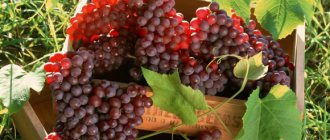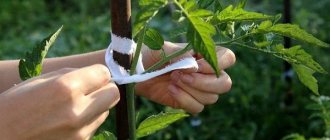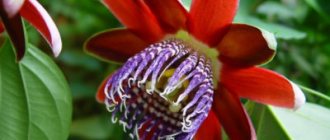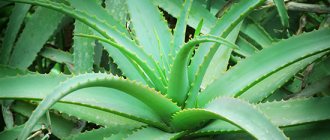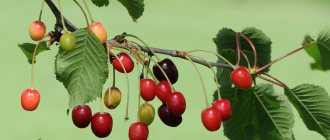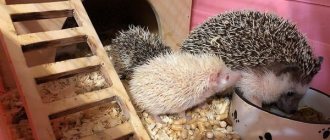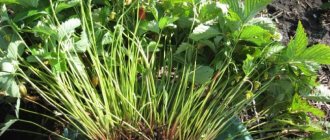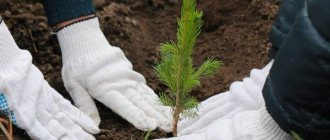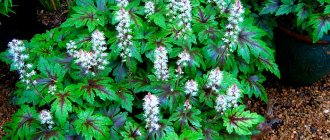Every summer resident wants the most productive strawberry bushes to grow and produce more and more berries.
One of the main methods of propagation of strawberries is propagation by mustaches. Dear readers!
For you, we have created communities on social networks in which useful articles and interesting ideas are published several times a day! Subscribe and receive useful content in a convenient format! In this article we will look at this method in detail. Let's look at its varieties and discuss the advantages and disadvantages.
Benefits of propagating strawberries with mustaches
This method of propagating strawberries has many advantages. Let's list the main ones.
- You can decide for yourself which bushes you will propagate. You can take the most productive ones or those with the most delicious berries;
- There is no need to struggle with seedlings, sowing seeds and transplanting seedlings;
- No containers for seedlings are needed;
- There is no need for an additional greenhouse or greenhouse;
- You don't need to buy new seedlings;
- The best characteristics of a particular strawberry variety can be preserved;
- The rosettes quickly take root and grow well.
Strawberry diseases Victoria
In order not to lose the harvest, it is important to prevent the occurrence of diseases. The Victoria strawberry variety is susceptible to the following diseases:
- Gray rot
. Signs: brown spots increasing in size, the fruit becomes soft and rots. Such a disease is incurable. The bush needs to be pulled out and burned. - Powdery mildew
. The disease manifests itself as a white coating with drops of liquid. The leaves curl and dry out. Spraying with milk or whey is used as therapy. The desired composition is obtained after dilution with water in a ratio of 1:3. - Verticillium wilt
. Fungal disease is the most dangerous. Spores can remain in the ground for 15 years. The main feature is dried lower leaves. Then the bush begins to gradually fade. Strawberry Victoria cannot be treated; it is impossible to save the bush. - Spotting
. Round dots of a red-brown hue appear. Over time, the entire green mass becomes covered with spots. Bushes with detected disease are removed, and the ground is treated with Bordeaux mixture. - Late blight
. Signs are brown spots on the leaves. The berries become dark and hard. Copper sulfate or “Fitosporin” is used for treatment.
What kind of strawberry mustache is taken for reproduction?
Rosettes of the first order (first line), that is, those closest to the mother bush, are suitable for propagation. They must be healthy and show no signs of infection or disease.
After you have decided on the rosettes suitable for propagation, the mustache must be trimmed so that the rosettes of the next order do not take away nutrients.
The second important nuance when choosing a mustache is that bushes no older than 2 years are chosen for propagation. Older ones will give poor offspring.
ON A NOTE. This is the general rule for selecting strawberry mustaches. Some summer residents generally leave only one of the strongest sockets. Others, on the contrary, use second-order sockets when there is a shortage of planting material.
Advantages of seed propagation. Soil preparation and planting features
Propagating strawberries by seeds
Beginners in gardening should learn more information about how strawberries are propagated by seeds. The procedure is very simple and has a number of advantages:
- seeds can be stored for several years without losing their germination;
- viruses and plant diseases are transmitted much less frequently through them;
- With simple manipulations, varieties that do not produce tendrils can be propagated.
Before you start propagating strawberries by seeds, you need to purchase raw materials from a specialized store or collect them yourself. There is nothing complicated about harvesting grains:
- Ripe large berries are selected from a healthy strawberry bush;
- Large seeds with a thin layer of pulp are cut from the middle or at the base. They should be dried naturally, spread out on filter paper.
- After drying, the mass is ground in hands to completely separate the grains from the pulp.
- The resulting raw materials can be stored in glass containers.
Soil and seed preparation
Strawberry propagation - soil and seed preparation
Strawberry propagation by seeds can be started in the last days of February at home, using prepared containers with soil. It is necessary to achieve a suitable soil consistency; it is necessary to prepare a mixture of peat, humus, sand and black soil in a one to one ratio.
The substrate needs ventilation, and the formation of a crust is unacceptable, the main thing is that the earthen surface is characterized by increased friability. This must be closely monitored and protected from drying out.
Cover the prepared mixture with a handful of soil on top without compacting it. Before planting, seeds are soaked in water with the addition of Kornevin, for faster rooting of seedlings. Later they are heated in the sun, on the windowsill for about 7 hours.
Now the strawberry seeds can be planted in the prepared soil mixture. The depth should not exceed 15 mm. It is necessary to constantly maintain the moisture of the top layer of the substrate. The optimal temperature for growing is 19 degrees Celsius. It will take a little more than a month for the shoots to appear. After this, the containers must be placed in a well-lit place. When the leaves appear, the plants are planted and then, when they grow, they are planted again.
Landing in the ground
Propagation of strawberries - planting in the ground
Strawberry rosettes are fully formed around the end of May, at which time they are transferred to open beds. For this, it is better to choose a cloudy day.
In stable sunny weather, it is necessary to provide the seedlings with shade using available means in the first few days. In order for the seedlings to finally take root, regular evening watering is carried out.
How to determine a suitable landing site
For strawberries, areas that are well lit and warmed by the sun are suitable. In the shade, the berries turn out small and tasteless. It is ideal if the strawberry beds are protected on the north side by bushes or buildings.
The crop should not be planted after peppers, tomatoes, potatoes, zucchini, pumpkins, cucumbers, eggplants, roses and lilies. Good predecessors for strawberries are root vegetables, herbs, garlic, and onions.
It is also worth noting that the crop is demanding of moisture, but does not really like it when groundwater lies too close to the surface.
Strawberry growing technology
Growing strawberries has its own characteristics. For example, steep slopes are not the best place for growing it. It is not advisable to grow it in lowlands, since cold air accumulates there. This is why plants get sick and don’t bear fruit well.
Strawberries love moisture, but they cannot tolerate severe waterlogging. To plant it, you need to choose a place that will be protected from the winds.
The root system of the plant partially freezes out already at a temperature of -10-12 degrees. Therefore, it needs to winter under a layer of snow at least 25 cm high.
You need to know that this crop should not grow in one place for more than 4 years. For the reason that various fungal and viral diseases accumulate in the soil.
It is better to grow Victoria in slightly acidic soils. It is also possible on sandy and loamy soils, but you need to add fertilizer or humus to them before planting.
On sandy soils, the plant usually produces a small harvest and the berries grow small, because the plant constantly experiences a lack of moisture.
In lowlands with high groundwater, planting beds are made 35-40 cm high. The width of the bed should be 95-100 cm.
Fertilizer application
If the soil is loamy, then it is necessary to add one bucket of peat and humus per 1 m2. And if the soil is sandy - a bucket of humus, a bucket of peat, a bucket of turf soil and up to 4 kg of sawdust.
6 kg of manure humus and 10 kg of sand are added to peat soils.
In clay soils - 10 kg of compost or manure humus, 12 kg of sand and up to 5 kg of semi-rotted sawdust.
Mineral fertilizers must be applied to all soils: per 1 m2 - 2 tbsp. l. nitrophoska.
In the beds that you make in the fall, you need to additionally scatter a glass of wood ash and 2 glasses of dolomite flour per 1 m2.
If you make beds in the spring, then in addition to nitrophoska, you need to add 0.5 liters of wood ash.
You cannot add fertilizers with chlorine to strawberries, as they are dangerous for this plant.
Lime materials, including dolomite flour, can be applied to strawberries only in the fall, but not in the spring. Because fluff lime or dolomite flour contains calcium, which has a negative effect on growing strawberries.
How to properly transplant strawberry mustaches
Mustache transplantation should be carried out in late spring - early summer or late summer - early autumn. Each term has its advantages and disadvantages.
You need to choose healthy, productive plants for replanting. There is no need to grow berries and let the bushes grow mustache at the same time. The bush simply won’t handle all the functions at once.
There is no need to rush with the transfer. After the appearance of the mustache, they are given another 1.5-2 months to grow and gain strength, and only then are separated from the uterine bush.
Transplantation must be carried out carefully and on a previously prepared area. After planting, the rooted rosettes need to be looked after so that they are well prepared for wintering and fruiting in the next season.
Why do Victoria bushes wither already with strawberries?
Sometimes cases occur when the plant begins to fade and wither. In order not to be left without fragrant fruits, you need to know not only what to do if Victoria strawberry bushes dry out, but also what situations can lead to this. Among the reasons are:
- Lack or excess of moisture. Moisturizing is especially important during the period of fruit set and after the appearance of berries.
- Lack of heat or incorrectly selected area.
- Thermal burns. Similar problems can occur due to moisture evaporation and strong sun.
- Vitamin fasting. The strawberry/strawberry Victoria plant needs phosphorus and potassium.
How to propagate strawberries with a mustache step by step
Let's analyze the algorithm for propagating strawberries with a mustache in more detail:
- Identify the uterine whiskers and select the whiskers to be used for the procedure.
- When the rosettes on the tendrils begin to sprout roots, they are pinned to the ground and lightly sprinkled with soil or humus.
- Water the rosette every 3 days. Your task is to keep the soil slightly moist. If it rains, loosen the soil around it.
- A couple of days before transplanting, sprinkle the future strawberry planting site with sifted sand and loosen the soil.
- After a week or a week and a half, the rosettes can be seated. Rosettes must be healthy and developed, have at least 2 pairs of leaves. Ideally, the rosette should already be rooted and have roots about 5-7 cm long.
- Cut off the mustache 8-10 cm from the mother bush and carefully move it along with a lump of earth to a new place. Also, if space allows, the tendrils can simply be rooted in place by cutting them off from the mother bush.
- The depth of the grooves or planting holes is 2.5 cm. Planting should be done in increments of 30 cm between bushes and 50 cm between rows.
- Build a shelter for the transplanted rosettes from white agrofibre.
IMPORTANT! The procedure is carried out on a dry, fine day, but before lunch or after sunset.
How to propagate with mustaches in spring
Some summer residents consider spring-summer propagation preferable, since in this case the seedlings completely go through the adaptation period and are ready for wintering. Their point of view is based on the fact that the tendrils that strawberries produce in May and June are best suited for reproduction. The highest quality rosettes are formed on them, and buds are also laid for future fruiting.
Propagation by strawberry tendrils in autumn
However, traditionally the optimal time for mustache transplantation is from mid-July to mid-September, depending on the growing region.
Over the next 10 weeks before the onset of cold weather, the young bush fully adapts to independent life, forms a fully developed root system and lays buds for flowering next year.
IMPORTANT! When the rosettes are separated in late autumn, the bushes take root poorly, overwinter hard and bear full fruit only in the third year of growth.
When to replant strawberries: timing in spring, summer, autumn
Strawberries can be replanted in spring, summer and autumn. Transplantation and reproduction in each season has its own nuances and timing:
- In spring (in April before flowering). The advantage of replanting in the spring: weather conditions are milder, there is no heat, there is a lot of moisture in the soil, in such conditions the plants will take root well and will be able to grow a good root system. In the South, it is optimal to do this at the end of March, at the beginning of April, in the middle zone (Moscow region) - at the end of April, in Siberia, in the Urals - in the second half of May. The air temperature should rise to 10 degrees Celsius or higher. A suitable way to propagate strawberries in the spring is by dividing the bush or seedlings, but it will not be possible to propagate with mustaches, because they begin to form only in the summer.
- In summer (in August or July after fruiting). In summer, the procedure is carried out 2 weeks after fruiting. When transplanting strawberries in summer in July after harvesting, the plants will take root and have time to lay flower buds in August and produce a harvest next year. However, you should not perform the procedure in hot, dry weather. Optimal methods of propagation in summer: by mustache (preferably), by dividing the bush.
- In autumn (September ). Autumn also brings milder weather, so plants can take root well. However, autumn transplanting strawberries is not suitable for cold regions (Moscow region, Siberia, Urals), otherwise they may not have time to take root. In September, you can propagate the bush by dividing the bush, with mustaches (but you only need to root the mustache in the summer in June or July).
Note! Propagation and transplantation of strawberries in the summer after fruiting (in July or August) is considered the most effective.
What is pot rooting
Some gardeners use the so-called “pot rooting method” when carrying out the strawberry propagation procedure. Its essence is that the selected outlet is placed in a small seedling pot (plastic cup). In this case, the rosette remains connected to the mother bush.
Next, the new bush takes root in its container and grows its root system. Then it is separated from the mother bush and transplanted to a new location.
This is the advantage of “pot rooting”. After all, the roots of the rosette are not damaged during transplantation. You simply take a ball of earth entwined with roots out of the cup and root it in a new place.
Rules for sowing seeds
Before planting seed in the soil, it is necessary to prepare it. What will it give? Firstly, the seeds will sprout faster. Secondly, the gardener will insure against such surprises as plant diseases.
Thirdly, strawberries will be more resistant to temperature changes, and the bushes will grow healthy and strong.
Hardening and soaking
Well-groomed beds
The harvested seed is pre-processed. Dry seeds cannot be sown that way.
First, you need to carry out the stratification procedure by hardening the seeds in the refrigerator at a temperature of +4°, +5°. The seeds are placed on gauze moistened with water and covered with it. Typically, gauze with seeds is placed in a glass container or in a regular nylon lid. They last in the refrigerator for two weeks. Hardening is carried out in order to disinfect the seeds and develop plant resistance to unexpected frosts, which happens very often. During stratification, it is advisable to ensure that the gauze does not dry out.
If you don’t want to harden the seeds, the seed can be treated with a weak solution of potassium permanganate. Before this, the seeds must be soaked for several hours. All these procedures are necessary in order to disinfect the seed and wash out inhibitors from it that inhibit plant growth.
The hardening procedure is done three months before planting the seeds in the ground. Treatment with potassium permanganate and soaking - three days before sowing. The swollen seeds are ready for sowing.
Soil preparation and sowing
If a gardener wants to get a harvest in the first year, he needs to start seedlings from February.
Flowering and ripening of berries
If there is no such goal, the seeds are sown in April. Experienced gardeners recommend giving the plant a chance to rest in the first year of its life. The flowers are pinched and the strawberries are not allowed to bear fruit. The measure allows the plant to gain strength and get stronger, and prepare for winter.
A light substrate is prepared for planting seeds. Peat, sand, humus and garden soil are often mixed. Ratio 1:1:1:1. The soil should be light. Often the soil is calcined or spilled with a solution of potassium permanganate for disinfection purposes. This should be done two to three weeks before planting the seeds.
Seeds are sown in wooden boxes, plastic cups or peat tablets. Since the strawberry seed is quite small, the seeds are not deepened, but pressed into well-moistened soil. The container is covered with film or a glass lid until germination. Sprouts appear after about three weeks. Sometimes even after a month, depending on the variety. Keep the boxes with seedlings on the windowsill, the air temperature should be 20°-25°.
To successfully grow seedlings, you should follow several rules of care.
Expert opinion
Yulia Yurievna
I have a large garden and vegetable garden, several greenhouses. I love modern methods of cultivating plants and mulching the soil, and I share my experience.
Ask a Question
We recommend using purchased land, or collecting some from the forest. But it’s better not to use soil from the garden. First of all, it usually contains a lot of fungal spores and overwintering pests. And, besides, in such land there are a lot of weed seeds. Many novice gardeners, growing seedlings for the first time, do not suspect that weeds will also sprout along with them. They definitely need to be removed. The fact is that in the comfortable conditions that are created for seedlings, they will feel very good, and can even crush the garden crop. You should get rid of such plants immediately; we recommend using tweezers for removal so as not to accidentally harm the crop being grown. After disinfecting the soil, especially thermally, it is very important to let it stand for two or three weeks, since beneficial bacteria should have time to multiply there.
How to propagate the Norwegian way
To make strawberry rosettes easier to transplant, they can be planted in the Norwegian style. These are raised beds that are surrounded by boards. In this case, the plantings are covered with a film, which provides protection from atmospheric influences (rain, hail, wind and sun).
Norwegian beds are a really effective method in which the mustache takes root well. But there is a nuance. Inside the shelter, you need to constantly maintain suitable conditions for the growth and development of bushes: moisten the soil and loosen it, weed, and apply fertilizer. To do this, you will have to constantly remove and re-stretch the agricultural material that covers the strawberries.
How to care for a transplanted mustache
After you have transplanted, the seedlings will need to be cared for until the very end of the season. There is nothing complicated in this procedure, but it will require some attention.
The transplanted mustache must be covered with transparent agrofibre. This way you will protect the bushes from atmospheric influences: rain and sun.
Strawberries will have to be watered regularly, loosened and mulched. It is very important not to allow the soil under the berries to dry out. And mulch will protect the plantings from the growth of weeds.
After about 25-30 days, the transplanted mustache will need to be fed. It is best to use a comprehensive liquid berry fertilizer. You can buy any fertilizer from trusted manufacturers Agricola, Green Belt, etc. After feeding, the bushes need to be hilled up to stimulate root formation. The procedure must be performed carefully so as not to damage the roots.
The last stage of caring for transplanted rosettes is preparation for winter. The bushes are insulated with pine litter. This is the best material for covering strawberries. If you don't have pine needles on hand, use hay or straw.
ON A NOTE. If you did replant in the fall, then most likely you will not have to water the strawberries due to the rains that have begun. In any case, be guided by the condition of the soil.
Caring for strawberry seedlings
First of all, the gardener should monitor the appearance of condensation on the film or lid of the mini-greenhouse. As soon as it appears, ventilate the container. When the plant develops to two or three leaves, the seedlings must be pricked if they grow in a box and not in a separate cup. Do not remove the film from the containers immediately, but gradually. Open the plants for an hour or two and close them again. Accustom strawberries to the external environment gradually.
Keep the soil moist. This is especially true when seedlings are grown in peat tablets. Containers should not dry out. The soil should be moist, but not soggy.
Plants can be fed with complex mineral fertilizer for strawberries, diluted twice as much as indicated in the instructions.
Seedlings can be planted in open ground with 5-6 formed leaves. Before this, the seedlings must be hardened off in the open air. The seedlings are taken outside for several hours and brought back. The hardening procedure begins one to two weeks before planting in open ground.
Having grown strong seedlings, you can safely begin planting seedlings in the garden.
Expert opinion
Yulia Yurievna
I have a large garden and vegetable garden, several greenhouses. I love modern methods of cultivating plants and mulching the soil, and I share my experience.
Ask a Question
We still recommend pruning the seedlings, as this gives a new impetus to the development of the rhizome. It is better to plant seedlings in cups, since then it will be possible to plant them in open ground using the transshipment method, which will significantly reduce the traumatic nature of the process. When hardening, it is important that the seedlings spend several full nights outside before planting. To understand whether the bushes are ready for planting, you need to run your hand over the foliage. The leaves should be elastic to the touch and quickly return to their original position. If they are lethargic, then the landing should be delayed.
Why don't strawberries bloom, but produce mustaches?
There are several reasons for this problem:
Firstly , this is the degeneration of culture. Unfortunately, strawberries actively bear fruit only in the first 3-4 years. If more, then this is a happy coincidence and an exception to the rule.
Secondly , some varieties are genetically predisposed to the massive formation of new shoots.
Thirdly , strawberries may not bloom if the root collar is too deep.
Fourthly , the plant can be fed with nitrogen. In this case, it is necessary to replant and fertilize with nitrogen-potassium fertilizers.
Fifthly , it may be due to the wrong time of planting the berries and lack of lighting.
Which mustaches should not be used for reproduction?
The tendrils of those bushes that have already produced berries are not suitable for propagation. The rosettes will develop poorly, because the bush spent most of its energy on forming berries.
ON A NOTE. Thus, you need to immediately decide which bushes you will keep for berries, and which ones you will use for propagation.
Also, this method is not suitable for remontant varieties that are reluctant to produce aerial shoots.
If we talk about rosettes of 2-3 and subsequent orders, then they can be used for reproduction. But you need to understand that the harvest from them will be meager.
Common mistakes
- An attempt to propagate remontant strawberries in this way. Propagation by mustache is not suitable for these varieties of culture.
- Using all available sockets. Only the first ones are suitable for propagation, counting from the mother bush. The rest will produce small and tasteless berries.
- The mustache was trimmed at the wrong time . The ideal time to separate a new rosette from the mother bush is July.
- Repeated transplantation. Strawberries do not like to change where they grow. Therefore, immediately decide where you will transplant the new sockets.
- The growth of the mustache is not limited. The longer the mustache and the more rosettes on it, the smaller and worse they take root.
- The soil is not prepared properly. Strawberries love loose neutral soils. On other soils it takes root with difficulty.
- Excess organic fertilizers. Organic matter can be added when preparing the beds, but after replanting it is better to use ready-made complex fertilizers for berries.

